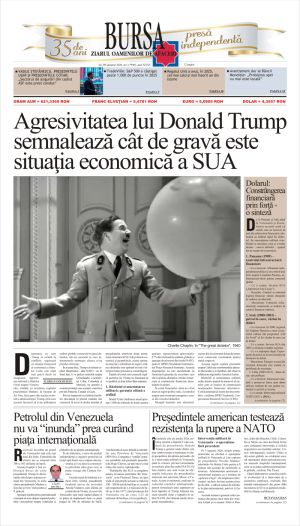Inflation has decelerated this year, while interest rates offered by commercial banks to the public have fallen slightly in recent months, but rates are still in negative real territory, which, in terms of purchasing power, favors borrowers over lenders, they say the analysts consulted by the BURSA newspaper.
According to the BNR, in September, the average interest on new deposits in lei granted to the population with a maturity of up to one year was 6.15%, down slightly compared to August, after a maximum of 7.09% in December last. For deposits with an original maturity of more than two years, the average interest rate was 4.8% in September, significantly below August's 6.27%, while the December 2022 record was 7.99%. In the case of new loans granted to the population for housing, with variable interest or with the initial fixed interest period of up to one year, the average rate in September was 7.57%, after a maximum of 8.6% in April, during as for loans with an initial fixed interest rate period of more than ten years, the interest rate in September was 7.01%, the record so far this cycle, according to BNR data.
On the other hand, inflation in September was 8.8%, down from 9.4% in August, but the BNR estimates inflation of 7.5% (±1.0%) for this quarter, which will down to 4.4% (±2.3%) in the fourth quarter of next year and 3.8% (±2.4%) in the second quarter of 2025.
• Aurelian Dochia: "Interests on deposits are not only determined by inflation and the policy of the central bank"
Economic analyst Aurelian Dochia does not expect an increase in interest rates in the foreseeable future, given the domestic environment, but in the current international context the situation can change very quickly.
He told us: "The interest on deposits is not only determined by inflation and the policy of the central bank, but an important factor is the treasury situation of the banks. If a bank already has a large stock of deposits that, for various reasons, it cannot place quickly enough in loans, it is obvious that it has no interest in attracting new deposits and raising interest rates on these deposits. This was the situation in our market; we have a loan-to-deposit ratio of around 70%, which is very low. Under these conditions, I do not expect an increase in interest rates (...). But I think that, in the very complicated and volatile situation we are in, things can go crazy very quickly."
Since January this year, after eleven interest rate hikes, the BNR has kept the key rate at 7% and signaled that interest rates will remain high to keep inflation under control.
In Mr. Dochia's opinion, an important factor that can at some point influence the policy of commercial banks regarding the remuneration of the capital raised is related to the programs of the Ministry of Finance that try to attract money from the population through high interest rates.
The economic analyst added: "Compared to inflation, in Romania, interest rates on both deposits and loans are really negative. It is a situation that usually occurs during crises. Especially in the case of crises related to wars, there is a period when markets operate at negative real interest rates, which is called repression, because depositors are losing. So creditors are losing and debtors are winning. When there are high levels of debt that cannot be paid, one solution is to frustrate depositors. Through this mechanism, part of their wealth is simply siphoned off in favor of borrowers, those who take loans at really negative interest rates. Everyone says that the interest rates have risen a lot, that no one can touch a loan anymore, but in reality the interest rates on loans are negative compared to the level of inflation. And there is a transfer of wealth from those who have to those who have not".
• Adrian Codirlaşu: "Over long periods of time, the volatility of interest rates is almost guaranteed"
Adrian Codirlaşu, vice-president of CFA Romania, emphasizes that in the ideal situation interest rates must be really positive, as is happening now in the United States. "In the US, reducing inflation was prioritized, and as the economy and labor market were strong, the Fed raised interest rates to 5.5%, and inflation fell to 3.7%. So for the dollar, the interest rate is really positive," said the CFA analyst. "In Romania, all types of interest are really negative. And a negative real interest on loans favors borrowers, because they give back less purchasing power than they receive".
According to the financial analyst, there is no single solution for all people who want to take a loan, but those who intend to borrow in the long term should expect the volatility of interest rates.
"If we look over a longer period, let's say the last fifteen years, we see that we had two crises, maybe even three. However, whoever wants to take a loan must take into account that, in a period of 15-20 years, we will have at least one crisis and maybe two or three recessions, which will affect interest rates. Recently we have had extremely high inflation leading to high interest rates; in the meantime they have decreased. Somehow over long periods of time the volatility of interest rates is almost guaranteed", said the vice-president of CFA Romania, adding: "There is no single perfect solution for everyone. There are different options - with fixed or variable interest, in lei or euros, but the solution depends on each person's income, if they are somehow covered against the increase in inflation, if they are in euros or somehow linked to the euro, etc."
• Aurelian Dochia: "For a five- or ten-year loan there is no big difference between IRCC and ROBOR"
Economist Aurelian Dochia says that accessing a loan with fixed or variable interest is an option that depends on how everyone sees the future, and in the case of loans with variable interest, over long periods, there is not much difference between the rates related to IRCC and those of ROBOR.
"For someone who is more optimistic, who believes that things will improve in the future, it is obviously good to take a variable rate loan in the hope that they will pay less interest. For someone worried about the international situation, a fixed interest loan seems like the right bet. I don't know what will happen tomorrow or a year from now, so it depends on everyone's perspectives," the economic analyst told us.
Aurelian Dochia added: "IRCC has a delay of six months and, in principle, there should be a very small difference between IRCC and ROBOR. It didn't happen all the time, there were periods when IRCC seemed more advantageous than ROBOR and there were people who switched from ROBOR to IRCC. But it depends a lot on the period we are talking about. In my opinion, for a five or ten year loan, there is not much difference between IRCC and ROBOR".
For his part, Adrian Codirlaşu emphasized that, at the moment, loans can only be taken with the interest rate linked to IRCC. "There are people who had interests linked to ROBOR but switched to IRCC and I think that over time, maybe in a few years, those with ROBOR will disappear", the CFA analyst told us.
On November 1, 2023, interest on deposits in lei ranged between 3.5% (one month at Patria Bank) and 7.10% (six months and twelve months at OTP Bank). OTP Bank has an interest rate of 6% per month, while Patria Bank has interest rates of 4.75% per twelve months.
The interest that depositors receive on three-month lei maturities varies from 4.00% at Patria Bank to 6.70% at OTP Bank. At six months, Patria Bank has the lowest interest - 4.25%, the highest level being at OTP Bank - 7.10%. For the nine-month maturity, the lowest interest rate on deposits can be found at Libra Internet Bank (5.75%), and the highest at Exim Banca Românească (6.75%).
For deposits in foreign currency (euro and dollars) for one month, the lowest interest is 0.1% in dollars at Patria Bank, and the highest interest is 2.5% in euros at OTP Bank.
For three-month loans, the lowest interest rate, 0.2% to dollars, is at Patria Bank, and the highest, 2.75% to dollars, is at Exim Banca Românească. At six months, Patria Bank offers an interest rate of 0.35% to dollars, and OTP Bank 3.3%.
For nine months, Exim Banca Românească has an interest rate of 3.5% in dollars. The maximum level of interest on deposits in foreign currency, 3.8% in dollars, is at OTP Bank, for twelve months.
In October, inflation in the euro area was 2.9%, the lowest level in the last two years and well below September's level of 4.3%. In the United States, in September inflation was 3.7%, a level similar to that of August.



















































